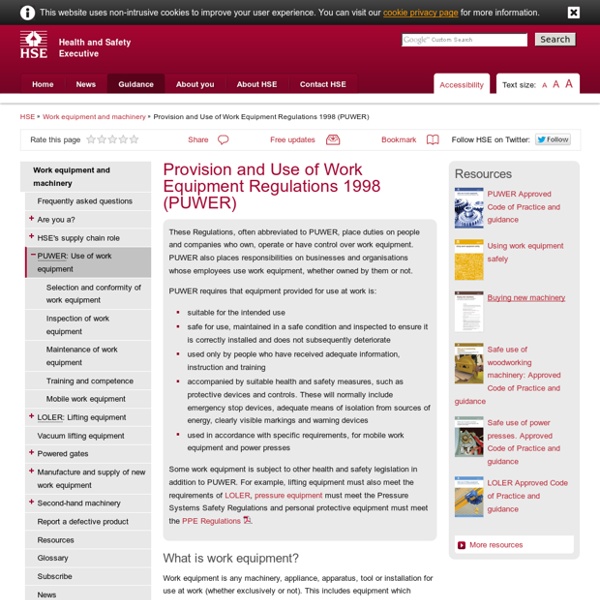Health and Safety at Work etc Act 1974 – legislation explained
The Health and Safety at Work etc Act 1974 (also referred to as HSWA, the HSW Act, the 1974 Act or HASAWA) is the primary piece of legislation covering occupational health and safety in Great Britain. The Health and Safety Executive, with local authorities (and other enforcing authorities) is responsible for enforcing the Act and a number of other Acts and Statutory Instruments relevant to the working environment. The full text of the Act (as amended) is available at legislation.gov.uk [1] where it can also be downloaded free of charge. Health and Safety at Work etc Act 1974 [2] This is the latest version.
Environmental Protection Act 1990
Part I establishes a general regime by which the Secretary of State, as of 2008 the Secretary of State for Environment, Food and Rural Affairs, can prescribe any process or substance and set limits on it in respect of emissions into the environment. Authorisation and enforcement was originally in the hands of HM Inspectorate of Pollution and local authorities but, as of 1996, became the responsibility of the Environment Agency (EA) and Scottish Environment Protection Agency (SEPA). Operation of a prescribed process is prohibited without approval and there are criminal sanctions against offenders. The Act aims to control and reduce pollution Part II sets out a regime for regulating and licensing the acceptable disposal of controlled waste on land. Controlled waste is any household, industrial and commercial waste (s.75(4)).
Laws and Executive Orders
Laws & Regulations You are here: EPA Home » Laws & Regulations » Laws and Executive Orders A number of laws serve as EPA's foundation for protecting the environment and public health.
Reporting of Injuries, Diseases and Dangerous Occurrences Regulations
The Reporting of Injuries, Diseases and Dangerous Occurrences Regulations 2013, often known by the acronym RIDDOR is a 2013 Statutory Instrument of the Parliament of the United Kingdom. It regulates the statutory obligation to report deaths, injuries, diseases and "dangerous occurrences" that take place at work or in connection with work.[3][4] One of the worst colliery explosions - The Oaks colliery disaster killed more than 300 people in 1866.[5] Even today, hundreds are killed at work each year in the UK The regulations require "responsible persons" to report deaths at work, major injuries caused by accidents at work, injuries to persons not at work that require hospital treatment, injuries arising from accidents in hospitals, and dangerous occurrences (reg.3(1)). Additionally, the law requires registered gas fitters to report poor and dangerous gas installations (reg.6). Responsible persons are generally employers but also include various managers and occupiers of premises (reg.2).
COSHH basics - COSHH
COSHH is the law that requires employers to control substances that are hazardous to health. You can prevent or reduce workers exposure to hazardous substances by: finding out what the health hazards are; deciding how to prevent harm to health (risk assessment[1]); providing control measures to reduce harm to health; making sure they are used ; keeping all control measures in good working order; providing information, instruction and training for employees and others; providing monitoring and health surveillance in appropriate cases; planning for emergencies. Most businesses use substances, or products that are mixtures of substances. Some processes create substances. These could cause harm to employees, contractors and other people.
Environmental Protection Act 1990
The Environmental Protection Act 1990, a UK act of parliament relating to controlled wastes is the successor to the Control of Pollution Act 1974 and makes provision for the management of pollution from industrial processes. The Environmental Protection Act deals with issues relating to waste on land, defining all aspects of waste management and places a duty on local authorities to collect waste. As a business, you have a duty to ensure that any waste your company produces is handled safely and within the law. This is your ‘duty of care’ and it applies to anyone who produces, imports, transports, stores, treats or disposes of controlled waste from business or industry. The Duty of Care Regulations 1991 places a responsibility over these individuals to:
Health and Safety at Work Act
Before 1974 approximately 8 million employees had no legal safety protection at work. The Health and Safety at Work Act 1974 provides the legal framework to promote, stimulate and encourage high standards of health and safety in places of work. It protects employees and the public from work activities. Everyone has a duty to comply with the Act, including employers, employees, trainees, self-employed, manufacturers, suppliers, designers, importers of work equipment. Employers' responsibilities The Act places a general duty to 'ensure so far as is reasonably practicable the health, safety and welfare at work of all their employees'.



